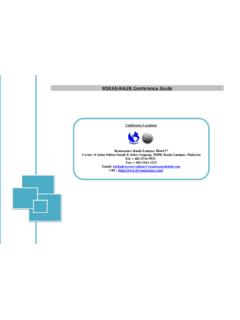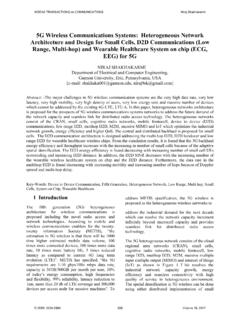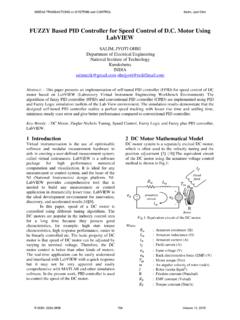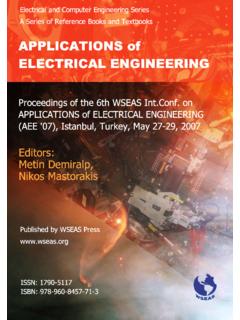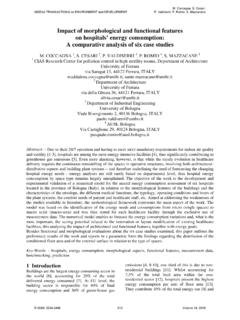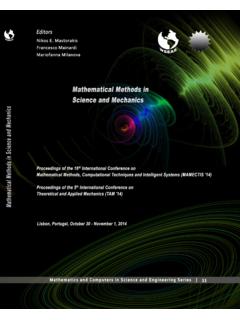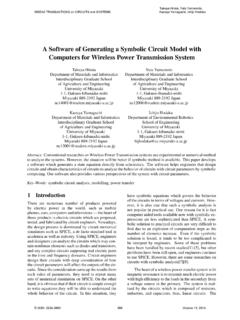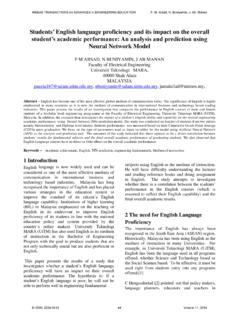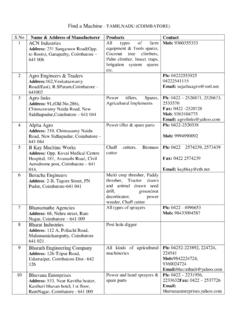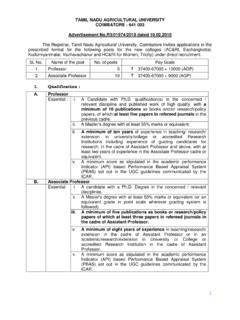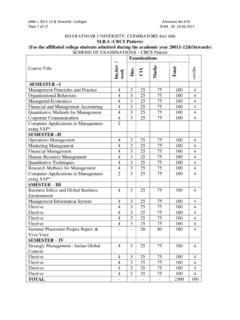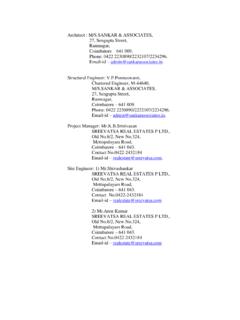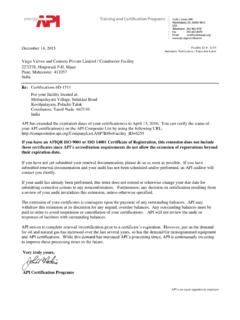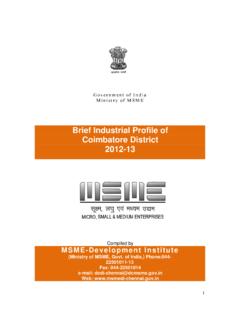Transcription of Optimal Location and Proximity Distance of Municipal Solid ...
1 Optimal Location and Proximity Distance of Municipal Solid Waste Collection Bin Using GIS: a Case Study of coimbatore City , , Department of Civil Engineering Avinashilingam University, coimbatore -641 108 Tamil nadu, INDIA SENTHIL Agni College of Technology, Chennai-603 103 Tamil nadu, INDIA Abstract: A better Municipal Solid Waste (MSW) management plans are required for developing urban cities in India. Further to facilitate MSW management, the enhanced options are to be provided for initial functions of MSW such as collection and transportation. The environmental and cost effectiveness of the functions would be achieved and analysed with adopting scientific technology like Geographical Information System (GIS). Hence, in this study GIS was used for investigating adequate number and positions of existing collection bins in one of the urban ward Sidhapudur, coimbatore , India.
2 The proposed numbers of collection bins were assessed according to MSW generation in the ward. Then the Optimal positions were found with reference to existing bin locations , road network and population density. Moreover, based on the public preferable walking Distance to drop the MSW to the collection bin, a model was developed. In this model, the three different Proximity distances such as 50m, 75m and 100m around existing and proposed bins were generated and found the Optimal Distance . As a result, the entire area was covered by 75m Distance around the collection bin with 99%. Thus, the proposed model suggested some modifications in existing system and which would recommend best possible collection services. Key Words: Municipal Solid Waste (MSW), Collection & Transportation, Collection Bin Number and locations , Optimal Position, Optimal Distance , Geographical Information System (GIS).
3 1 Introduction The developing country like India the quantity of Municipal Solid Waste (MSW) has increased with improved life styles and social status of the populations in the urban centers [21]. It is estimated that about 1,60,000 MT of MSW is generated daily in India. Per capita waste generation in cities varies from kg to kg per day depending upon the high living standards, the rapid economic growth and the high level of urbanization. An assessment has been made that per capita waste generation is increasing by about per year. With growth of urban population ranging between 3 to per annum, the annual increase in overall quantity of MSW is assessed about 5% [22, 29]. However, there are insufficient infrastructure and resources for the MSW management in many urban areas of the WSEAS TRANSACTIONS on ENVIRONMENT and DEVELOPMENTR.
4 Nithya, A. Velumani, S. R. R. Senthil KumarE-ISSN: 2224-3496107 Issue 4, Volume 8, October 2012 country. Also, suitable services to dispose most of the MSW from households are not up to the satisfactory level. The rapid generation of MSW leads to management issues in addition to environmental impact. [28]. Thus, Bani et al., 2009 suggested that the impacts can be minimized by the proper management with improved technology applications. In the management system, local administrative positions are more responsible for MSW management services, either directly or indirectly through sub contracting part or all of these services [5]. Especially, MSW collection and transport are provided at the individual municipality level. Currently, collection and transport of commingled MSW is responsible for a large portion of the total waste management costs, in the range of 70-100% [16, 14].
5 This is considerably higher than the typical values, between 50-75%, reported for modern waste management systems [23] because an adequate amounts is not used for the disposal of MSW due to the unawareness in pretreatment for materials and/or energy recovery and practicing of illegal dumping [5]. Therefore, the cost effective collection system and finding the appropriate number and Location of collection bins can be confronted with applying the sophisticated technology like Geographical Information System (GIS) computerized tool. In this context, the investigation of the related literature reveals that the GIS technology is used to computerize the waste management planning and design of waste collection and transport and disposal. Nowadays integrating GIS technology with MSW management has been recognized as one of the most promising approach to automate the process of planning and better management of MSW [13, 20].
6 Moreover, the IT related methods based on integrated GIS and multi-criteria techniques are mostly used for selecting appropriate landfill sites to dispose the MSW. For example, Svoray et al., (2005) and Higgs (2006) applied multi-criteria and GIS techniques to investigate the suitability of different land uses for residential, industrial, forest, natural conservation and also to investigate the possibility of public participation in the MSW management. Chang et al., (2008) used multi-criteria and fuzzy model with the help of GIS to find a site for the MSW disposal in southern Texas. The complex waste management systems, in particular sitting MSW management and disposal facilities and optimizing waste collection and transportation have been a preferential field of GIS applications from the early onset of the technology [7, 8, 9, 14, 23].
7 GIS is the most feasible methodology for designing an Optimal waste collection routes for the bin to bin collection in Spain [1, 18]. Teixeira et al (2004) applied heuristic techniques to solve a collection model in order to define the geographic zones served by the vehicles, as well as the collection routes for recyclable waste collection of Portugal. Christos Chalkias, Katia Lasaridi (2009) developed a model in ArcGIS Network Analyst in order to improve the efficiency of waste collection and transport in municipality of Nikea, Athens, Greece, via the reallocation of waste collection bins and the optimization of vehicle routing in terms of Distance and time travelled. Optimization of waste collection and transportation making use of the novel tools offered by spatial modelling techniques and GIS may provide large economic and environmental savings through the reduction of travel time, Distance , fuel consumption and pollutants emissions [3, 6, 12, 15, 19, 26].
8 Based on the investigation of literature review, the GIS spatial technique is a good decision support tool to implement for locating new bins in one of the main urban area Sidhapudur ward in coimbatore city, India. The objectives of the study are i. to review current MSW management practices including waste generation, Location of collection bins, type & size of collection bins and collection frequency of MSW removal from the bins WSEAS TRANSACTIONS on ENVIRONMENT and DEVELOPMENTR. Nithya, A. Velumani, S. R. R. Senthil KumarE-ISSN: 2224-3496108 Issue 4, Volume 8, October 2012 ii. to find and allocate new collection bins based on MSW generation using GIS technique and iii. to find the Optimal Proximity Distance for the collection bins by generating buffer zone.
9 Thus, the study helps in analyzing the present MSW collection issues and used as a decision supporting tool for efficient collection of MSW in the ward. 2 Present Scenario of Research Area The coimbatore city is situated in south India and it is around 11 North latitude, 77 East longitude and m above the mean sea level. The city had 72 administrative wards and recently the corporation boundary has been expanded to 100 wards with an area of Km2. coimbatore , known, as `The Manchester of South India . It is the third largest city in Tamil Nadu and houses numerous textile mills and small scale engineering units. The city has urban development and area having potential of rapid industrialization. It has an urban population of lakhs as per 2001 census and the provisional population as on 2010 is about lakhs (CMC).
10 The city generates an average amount of MSW is about 635 MT per day [11]. The city presently consists of four transfer station from where the wastes are transferred to disposal site which is situated in the place called Vellalore. Source segregation of waste is not properly being practiced. The study is carried out in one of the ward such as Sidhapudur, coimbatore (ward , old ) which is nearer to one of the transfer station. The ward map is shown in Description of the Ward The ward Sidhapudur comprises of diverse economical group of people and also consists of mixed residential and commercial areas. Large number of hotels, restaurants, city bus stand, offices and shops are located in the ward. This is one of densely populated urban ward in the coimbatore Corporation (Report on Business Plan for coimbatore Corporation, Nov, 2006).
